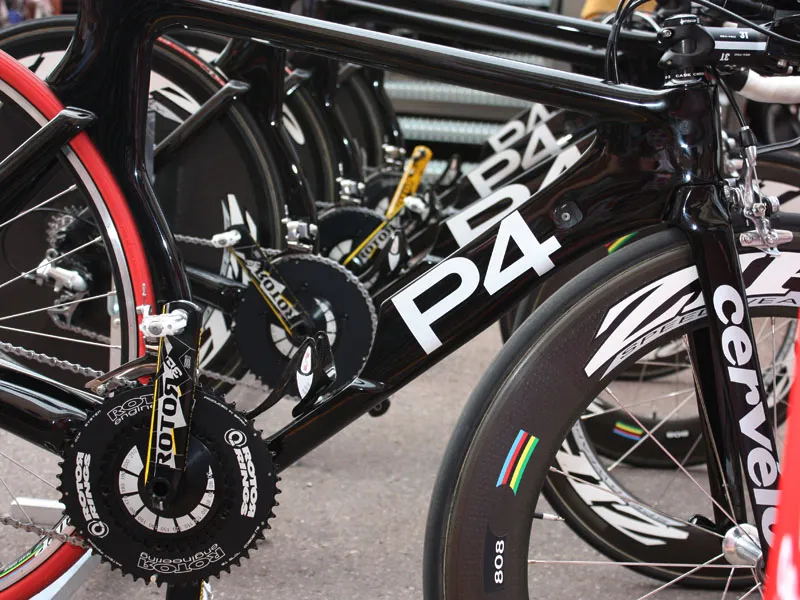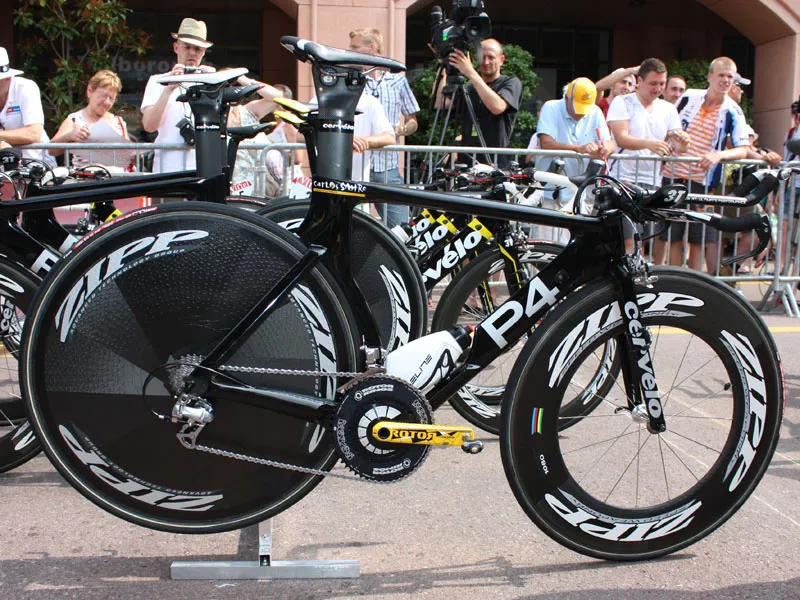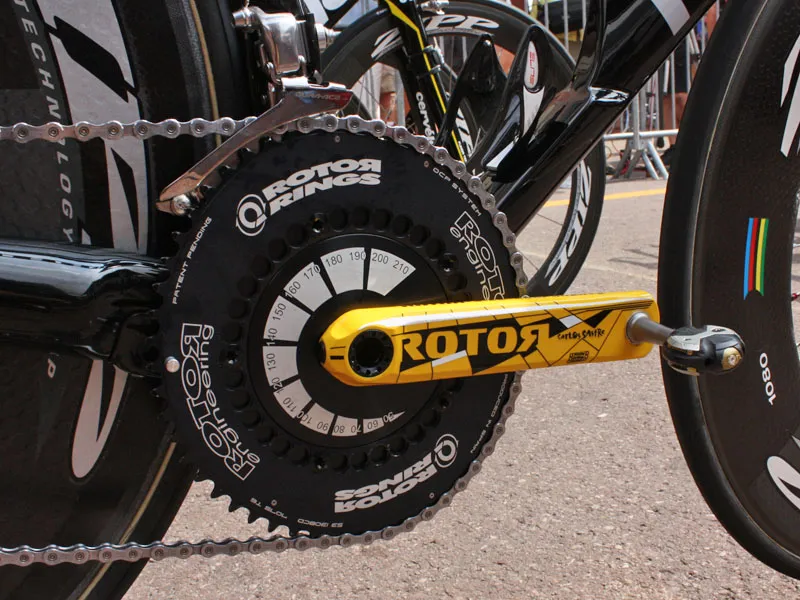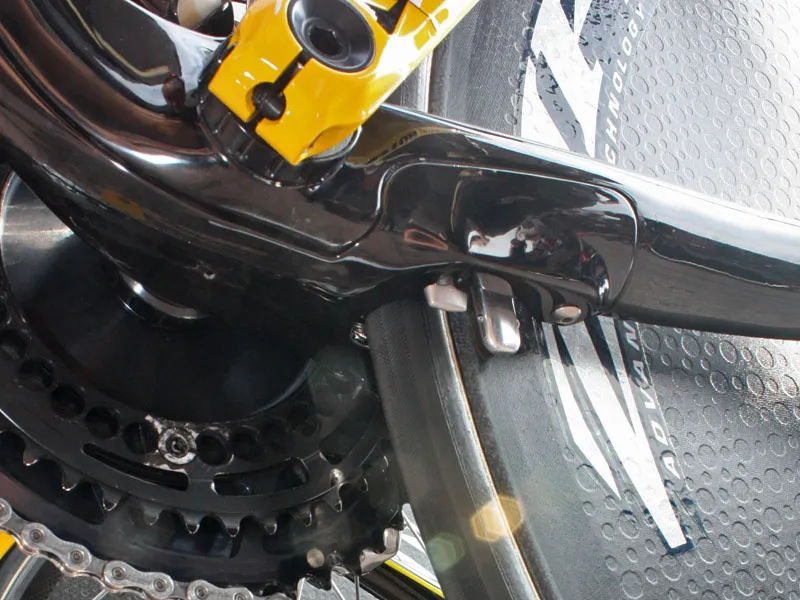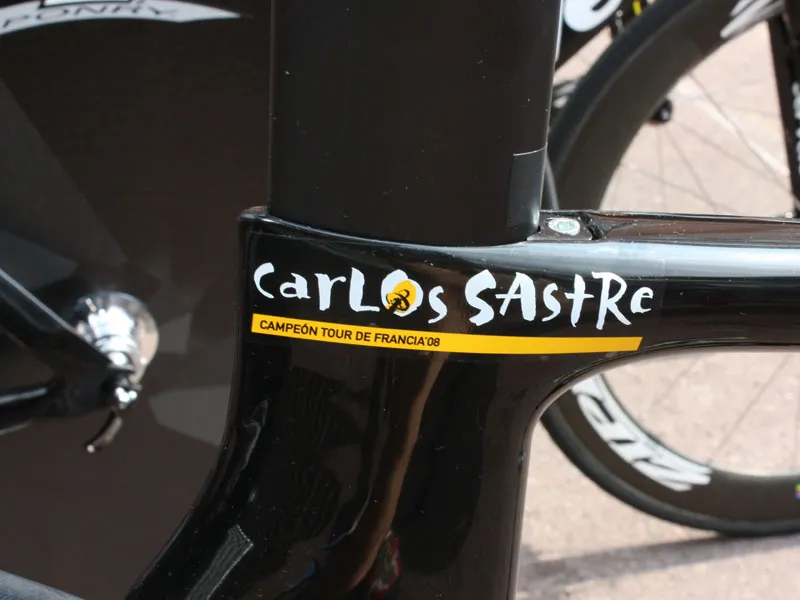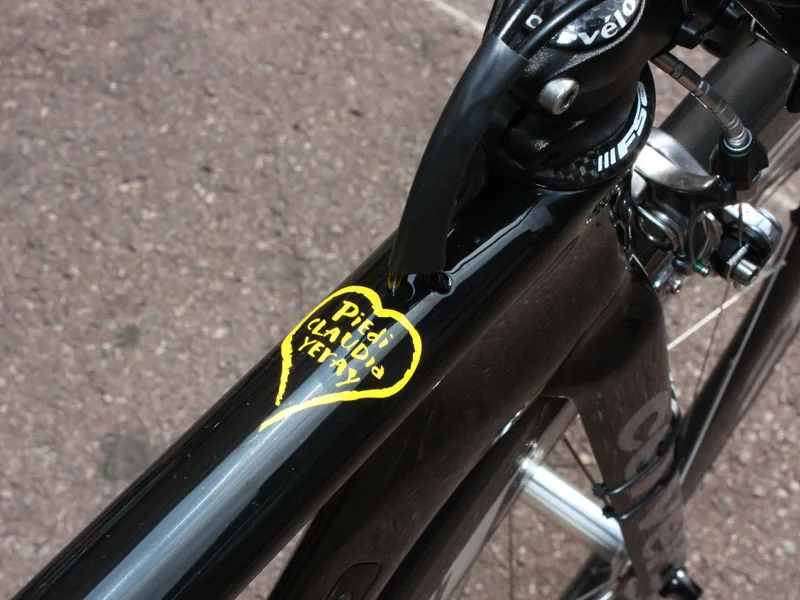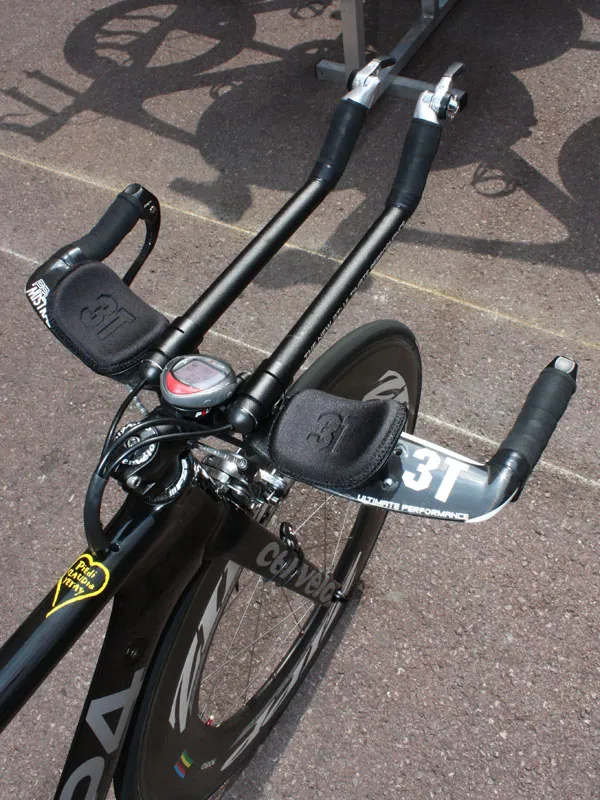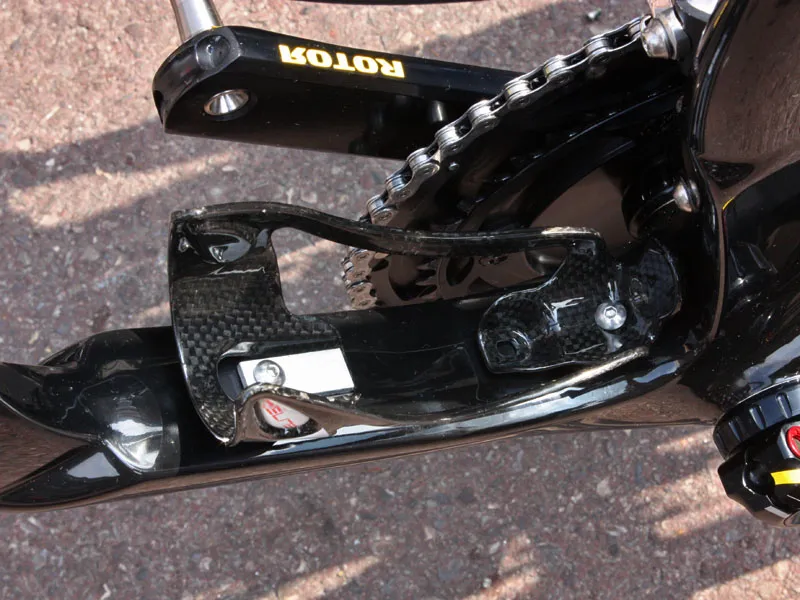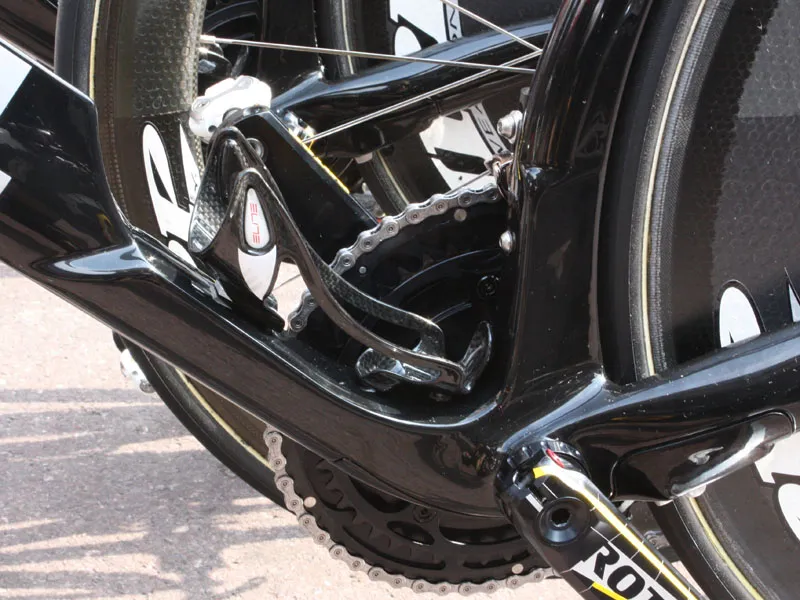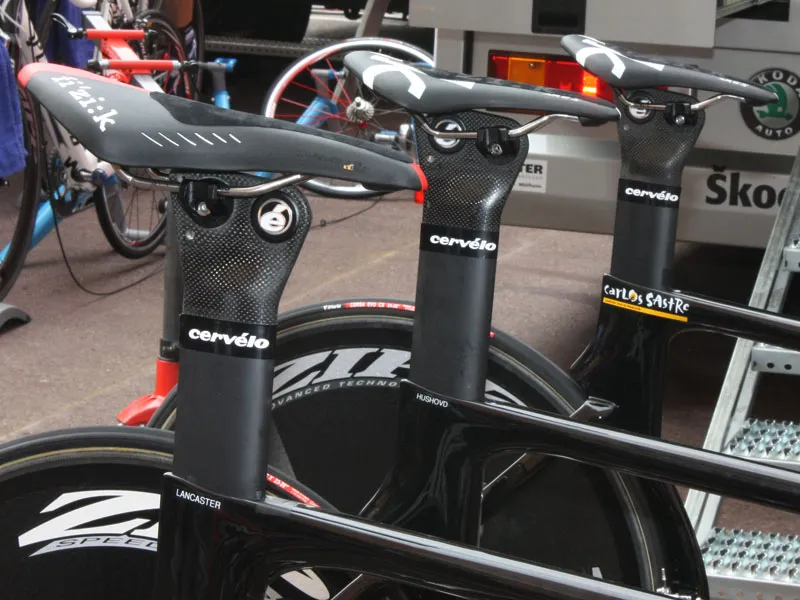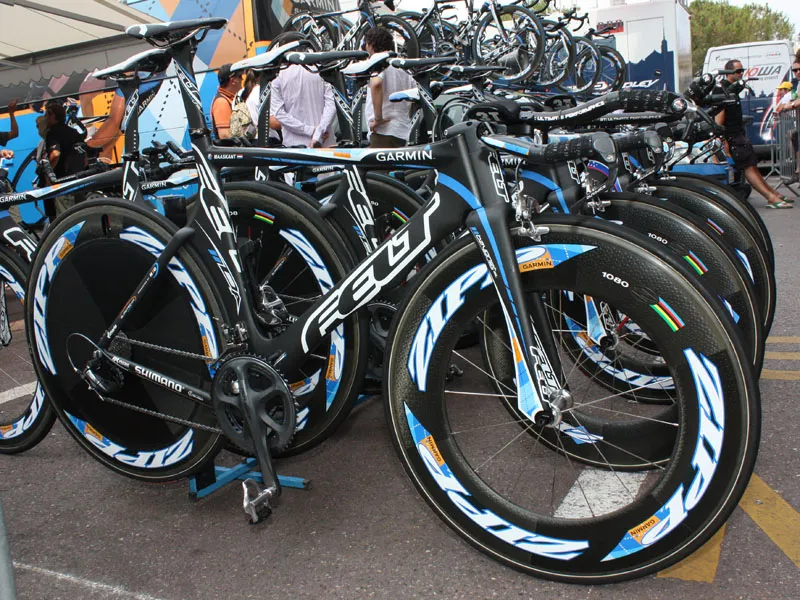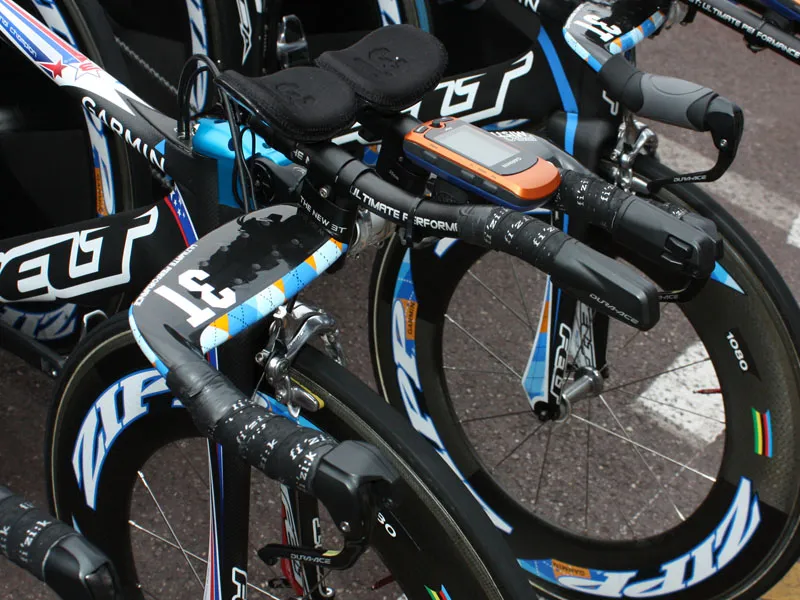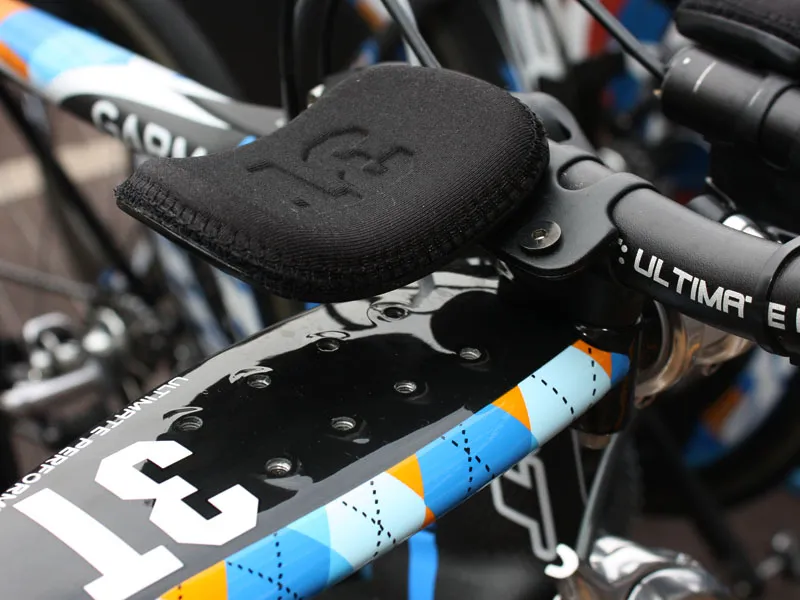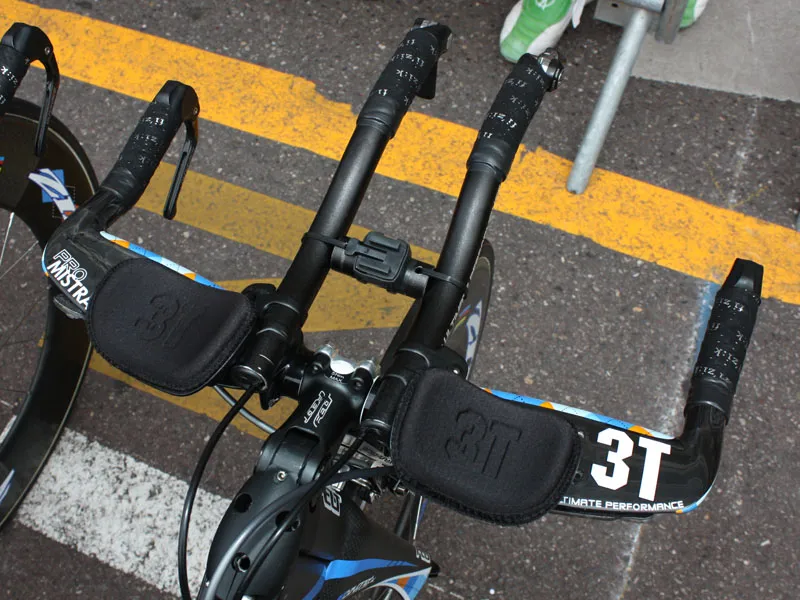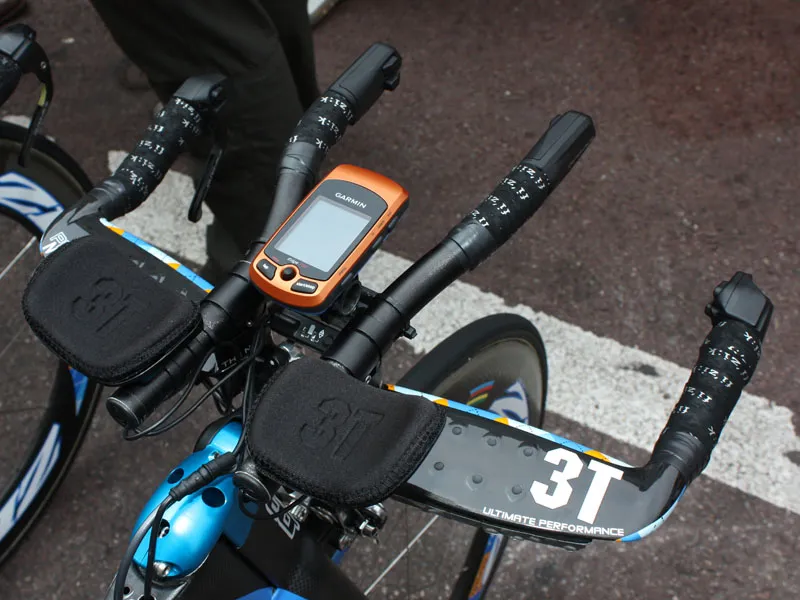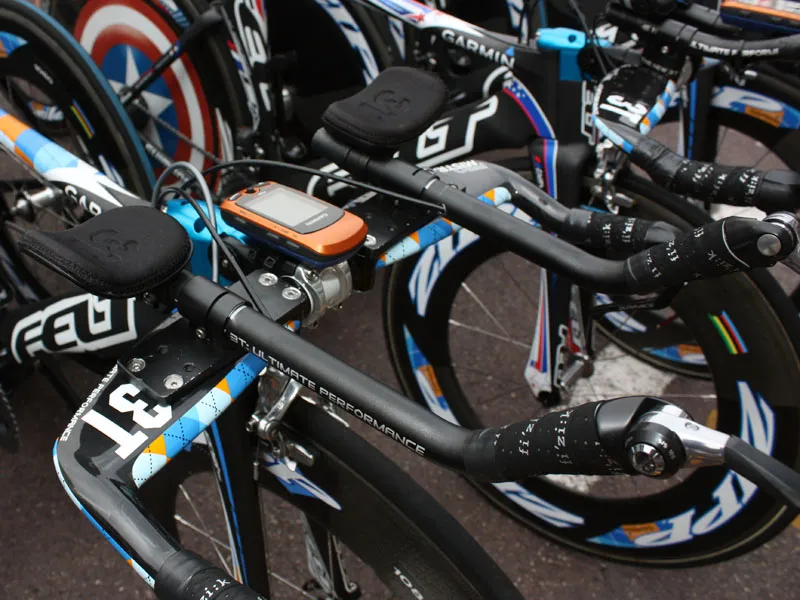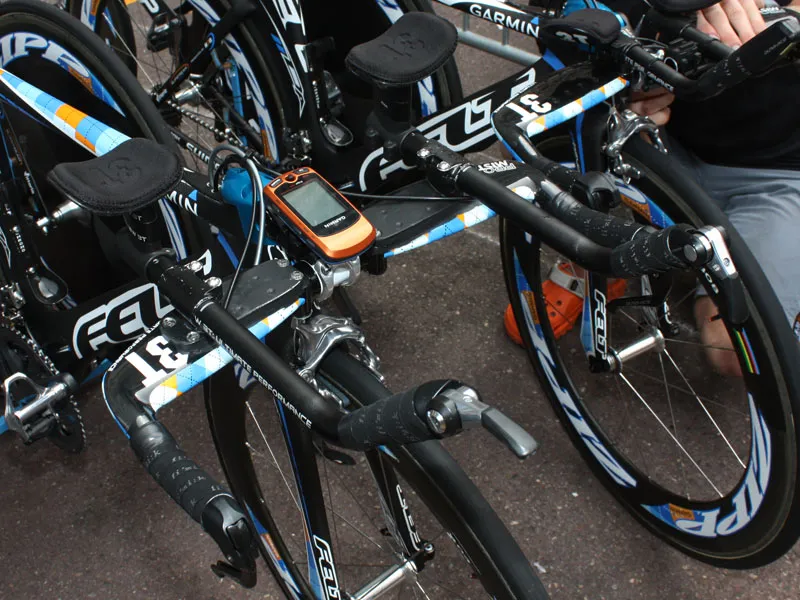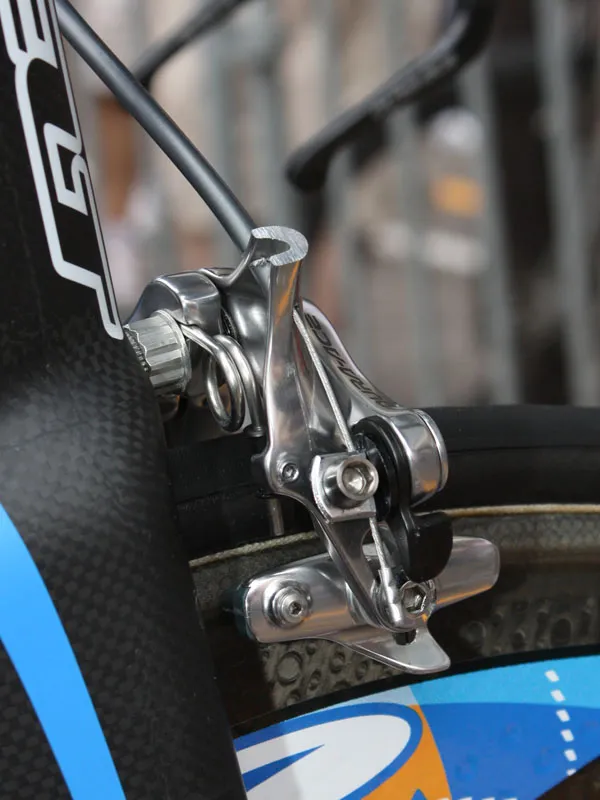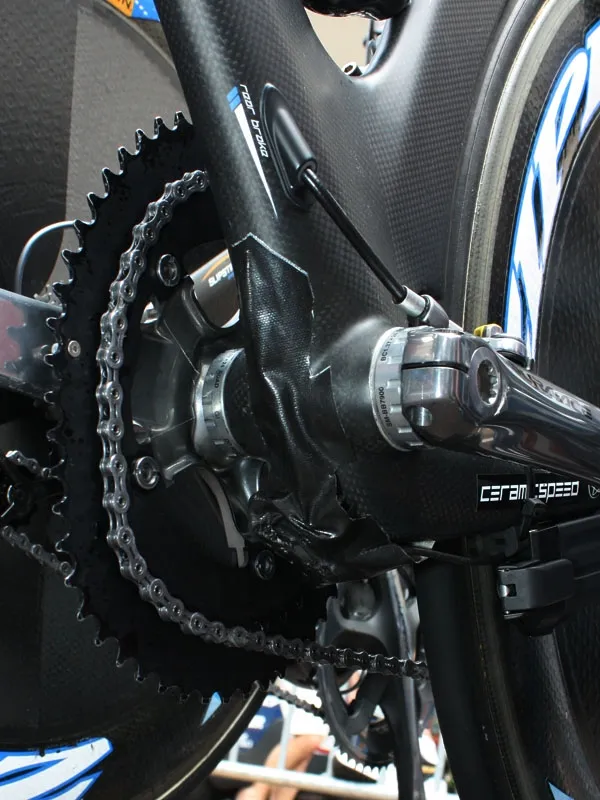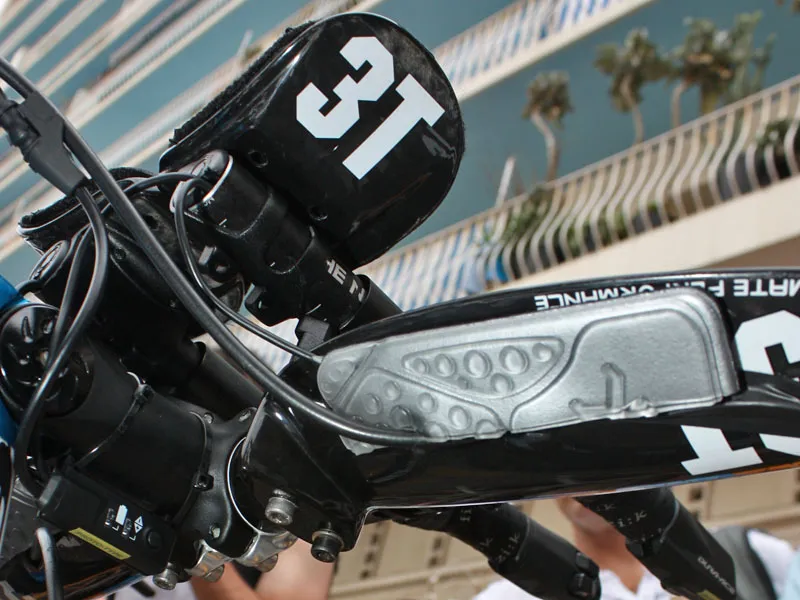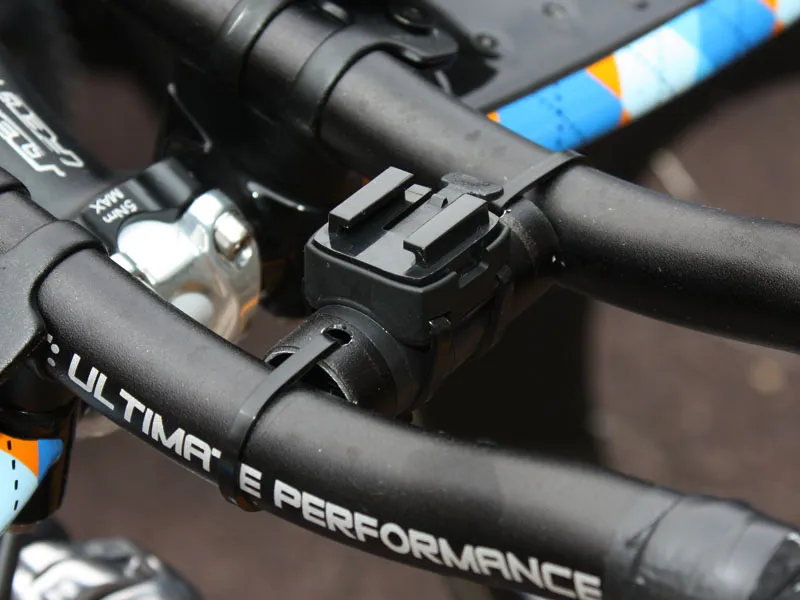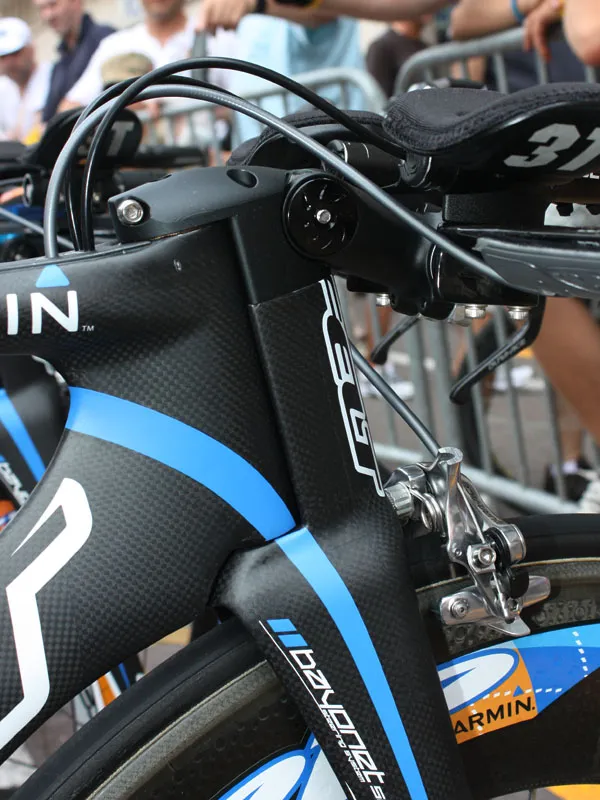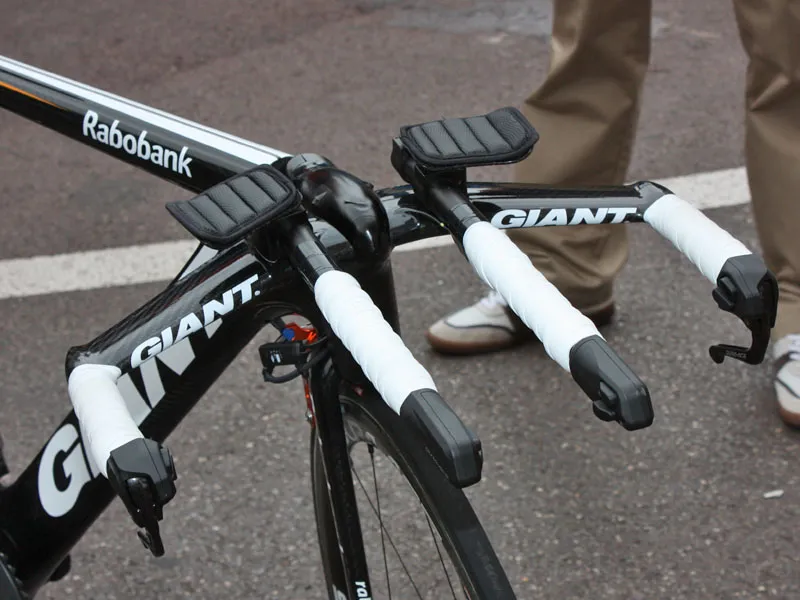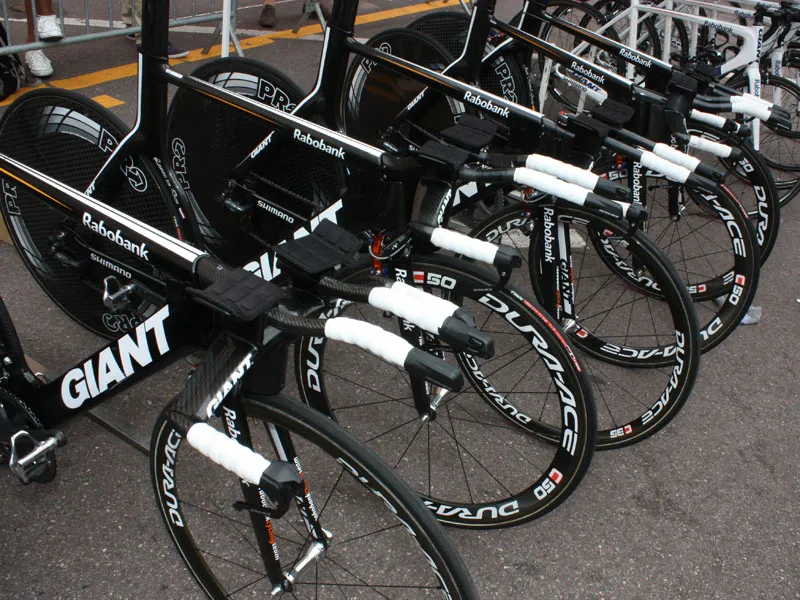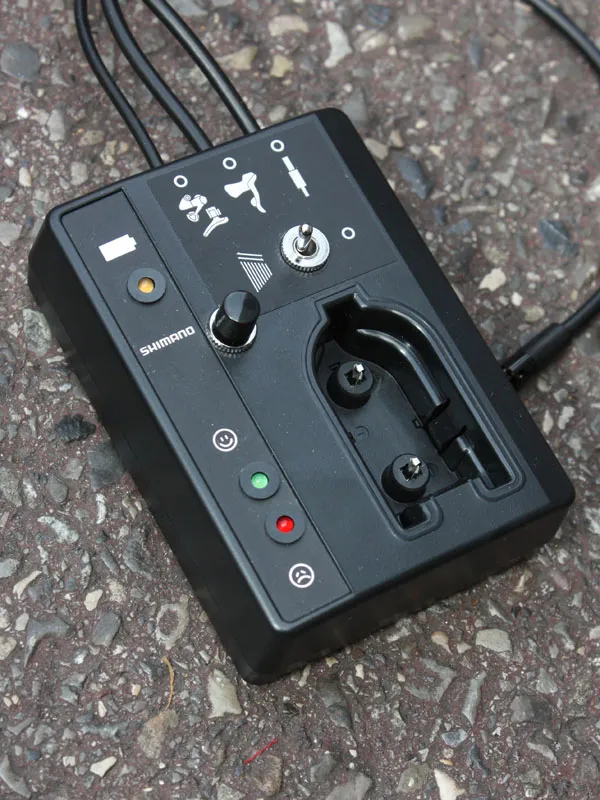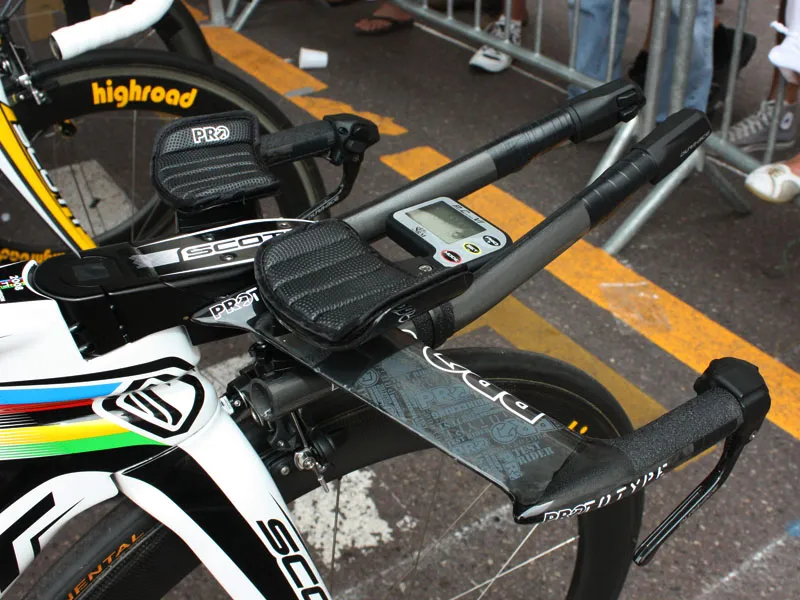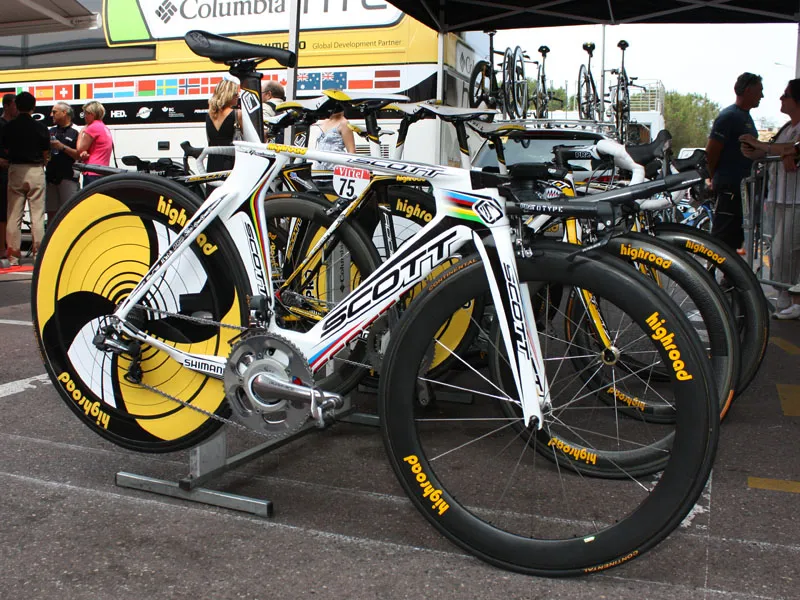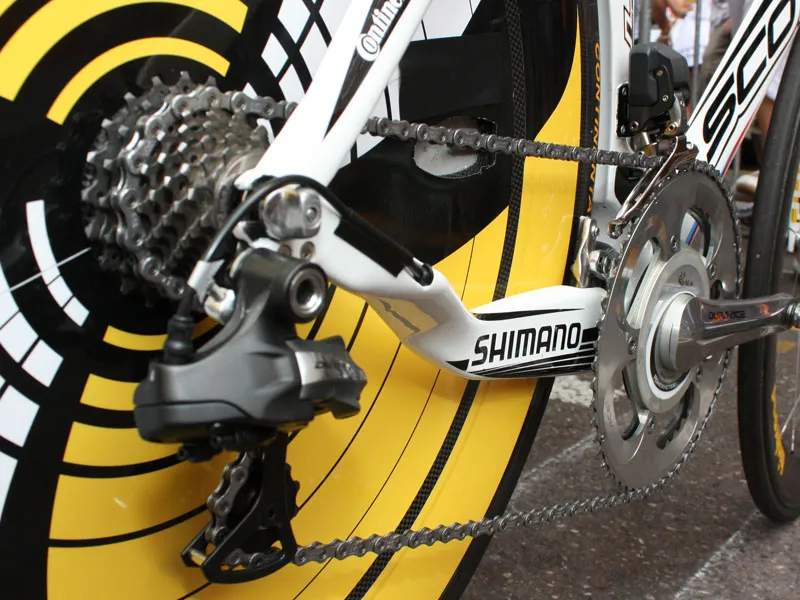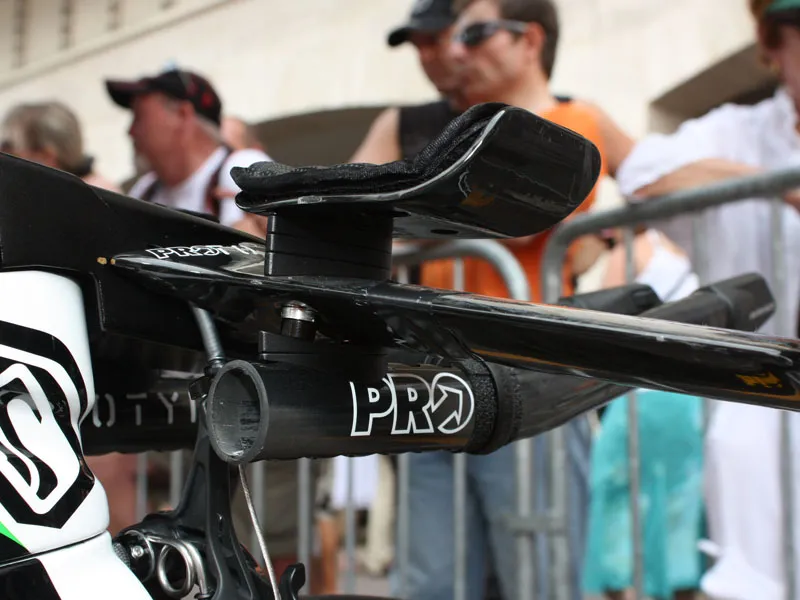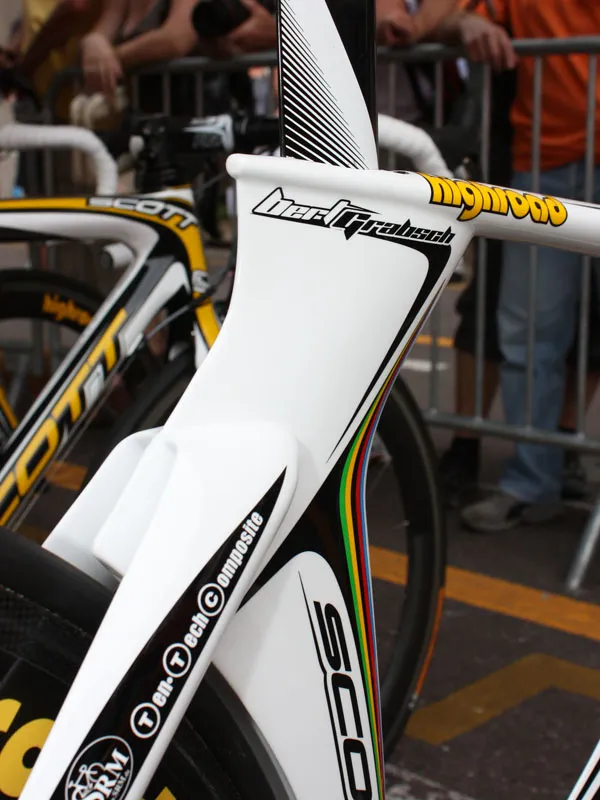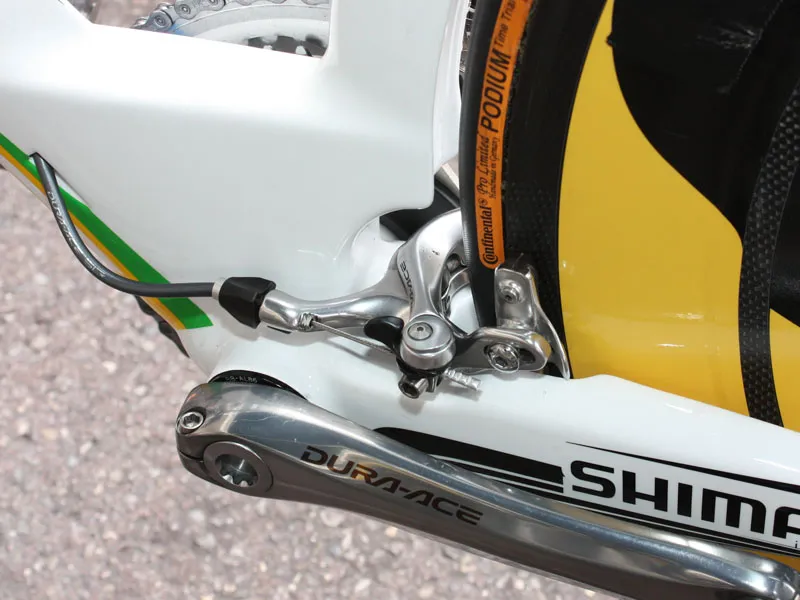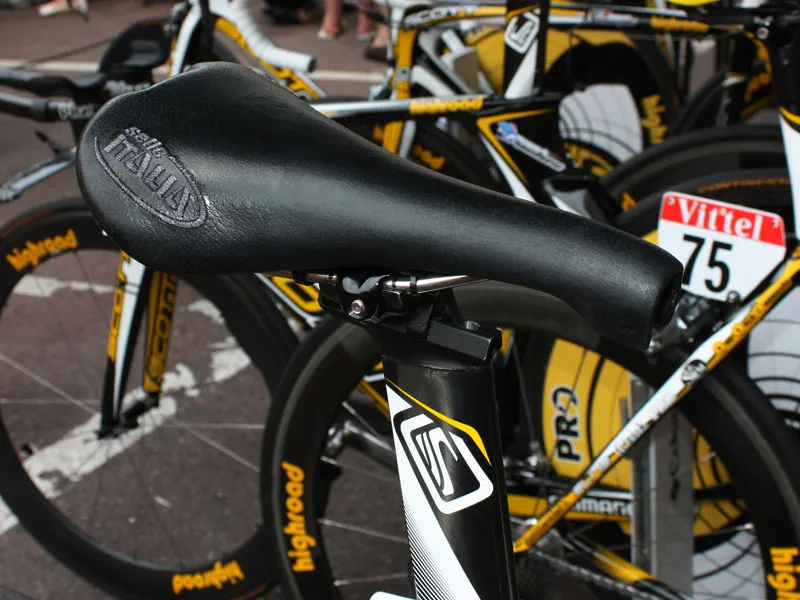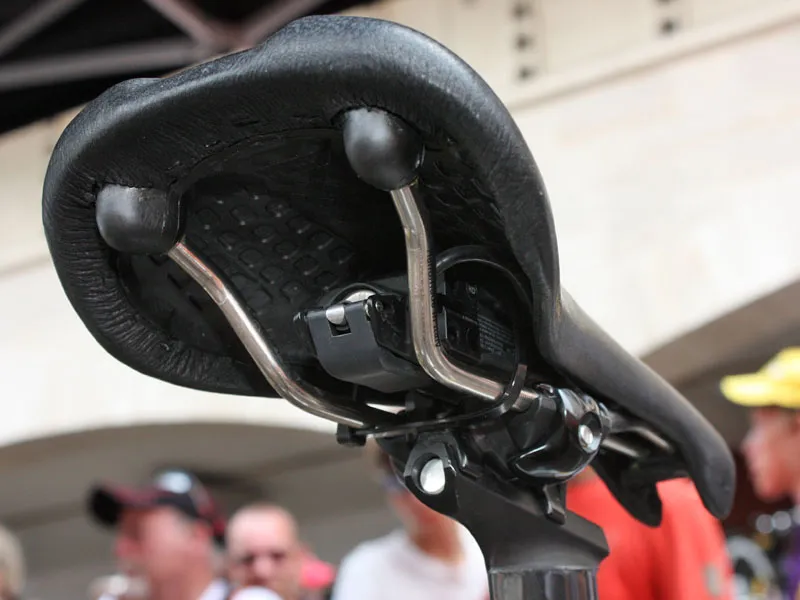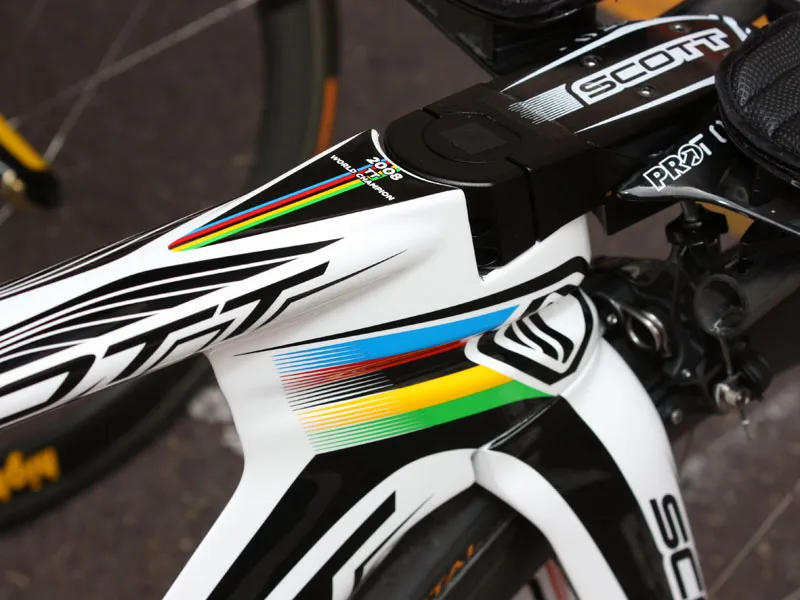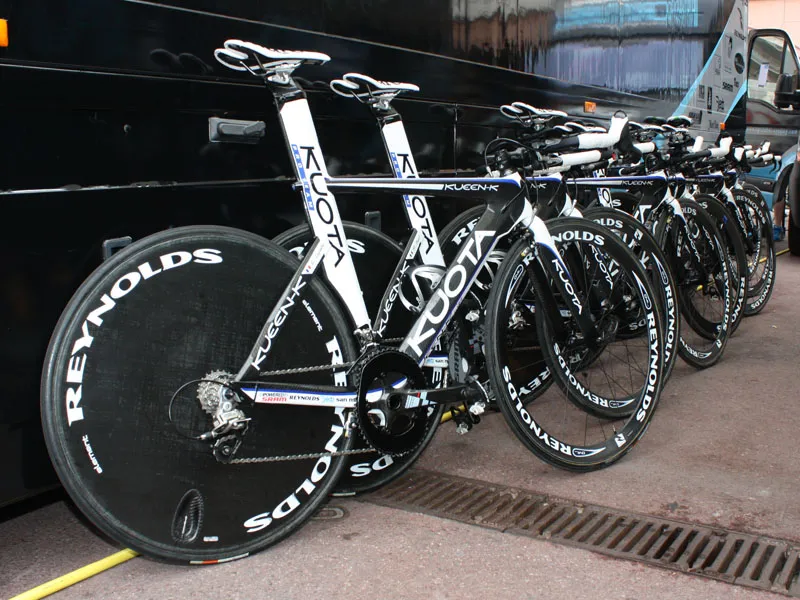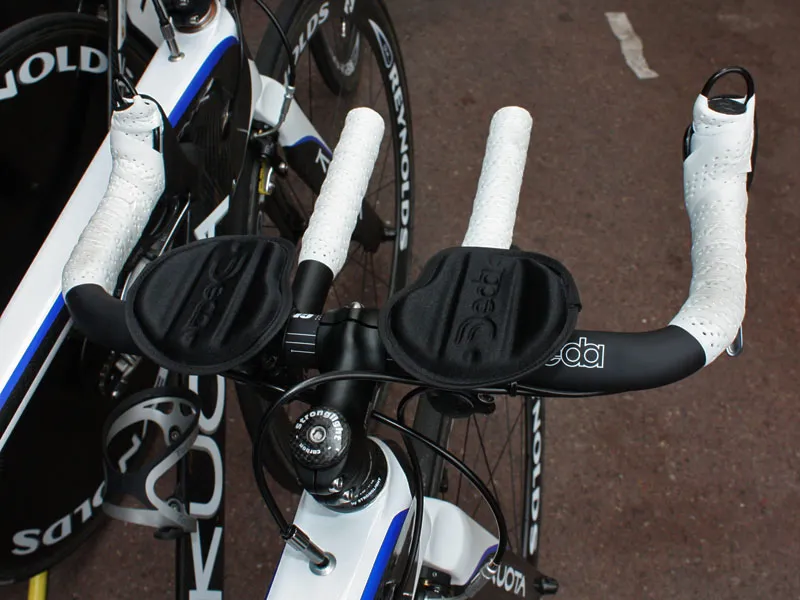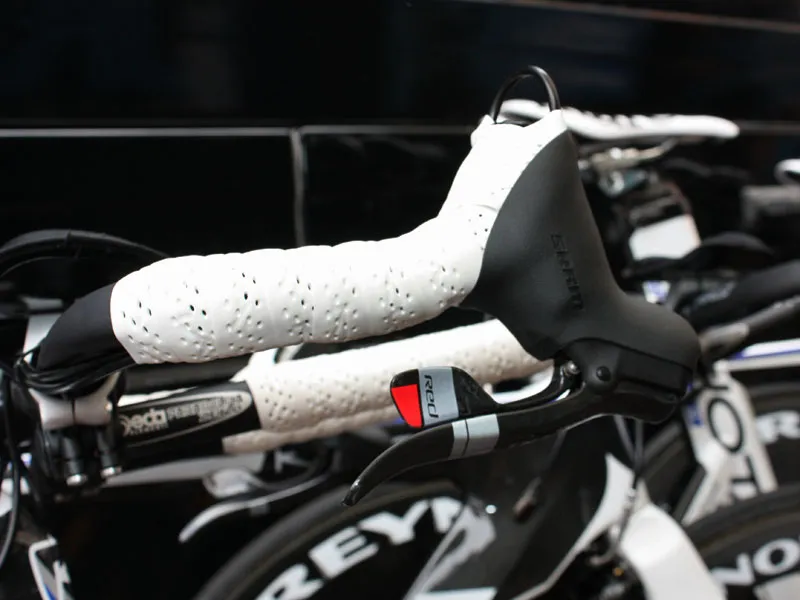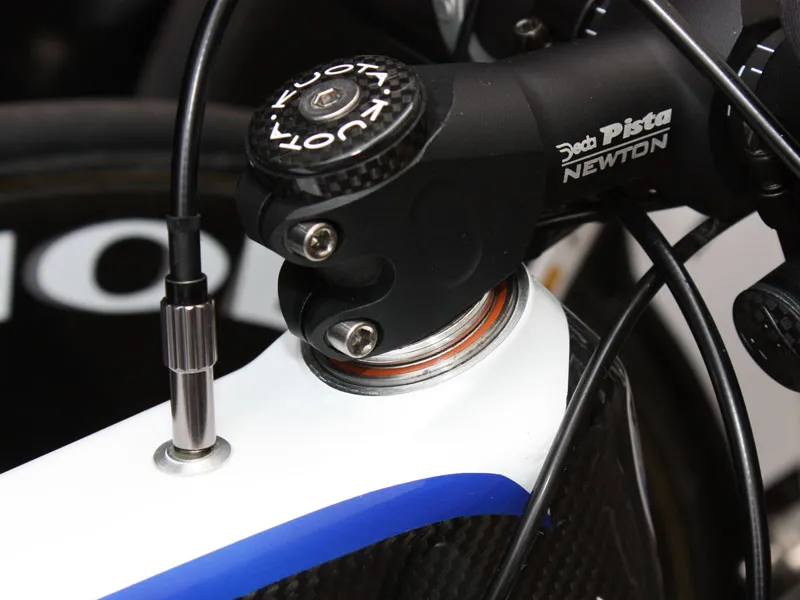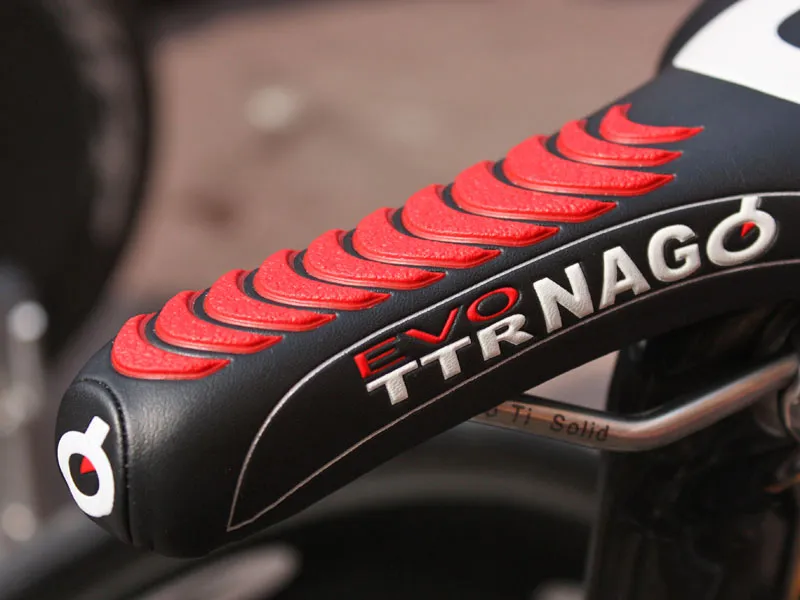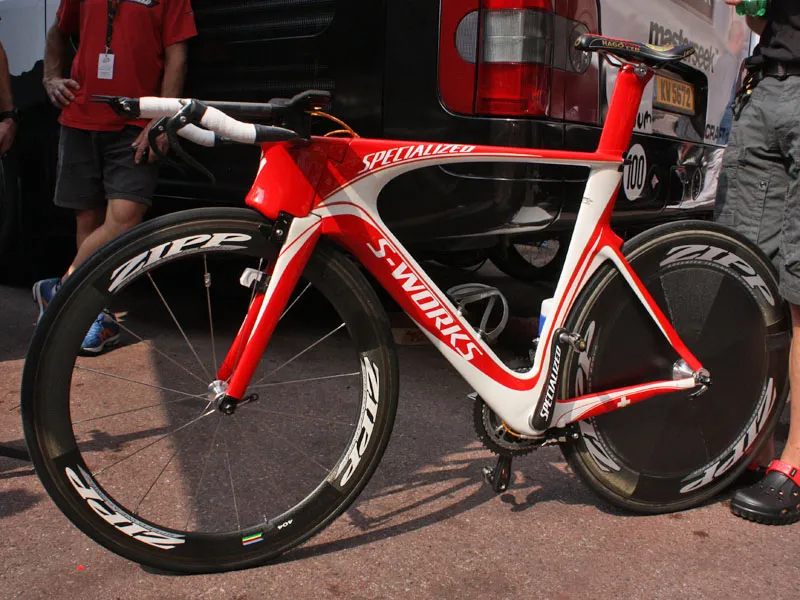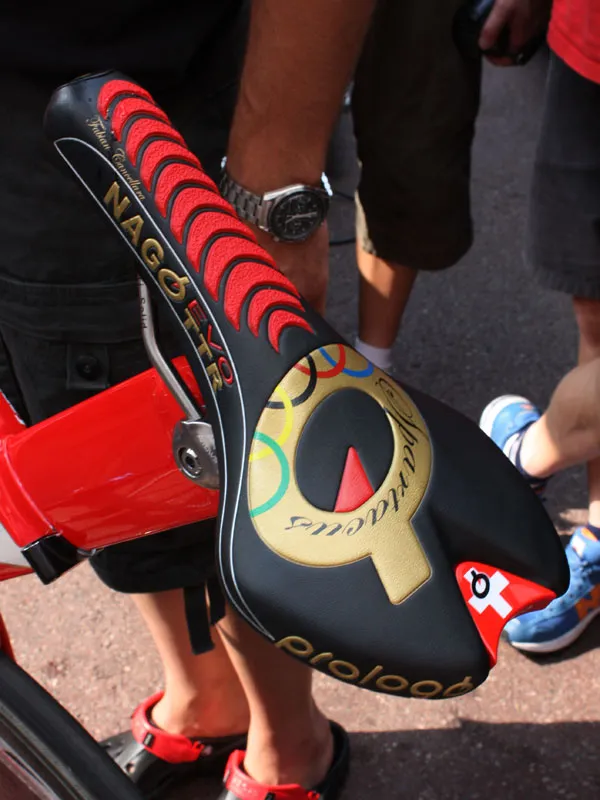This year's Tour de France marked the first time the entire Cervélo Test Team set off on the company's flagship P4 time trial bike. In response to rumours that the bike wasn't UCI-legal, company principal Gerard Vroomen insisted it was purely a production issue - he didn't want the team to race on it en masse until they were readily available to consumers.
Even so, there are still a few bits of homework to do, according to team test engineer Damon Rinard. In particular, the seatpost measures just over 3:1 but the UCI has apparently indicated it won't enforce seatpost dimensions until January 1. When that time comes though Cervélo will use a modified post and fill in the gap at the frame with some shims.
Another potential sticking point is the P4's unique integrated water bottle. Though not explicitly banned by the UCI, Rinard and the team preferred not to take any chances, instead using a customized aero cage and bottle from team sponsor Elite. Rinard says the cage modifications are easy to perform in case current P4 owners are concerned about scrutiny from their local federations, requiring just one additional hole in the cage and a short aluminium plate.
Most of the team P4s were also fitted with special versions of Rotor's new 3D crank. In contrast to the road-going 3D's external channels and five-armed spiders, this one sports smooth crankarm surfaces, solid-skinned outer chainrings as well as a complete chainring 'disc' for slightly reduced drag. Team leader Carlos Sastre's cranks were further customized with special graphics to commemorate his status as reigning Tour de France champion.
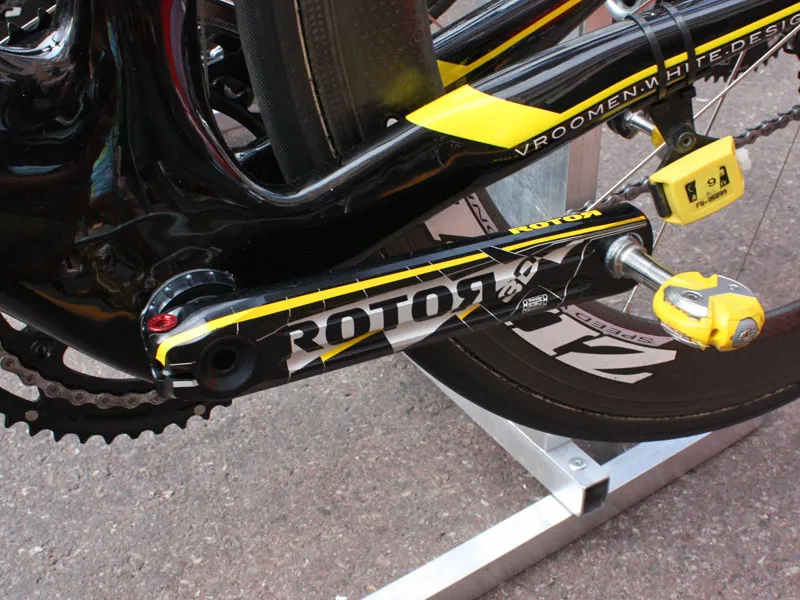
The standard Rotor 3D crank includes channels milled on the surface to save weight.
Garmin-Slipstream gets creative
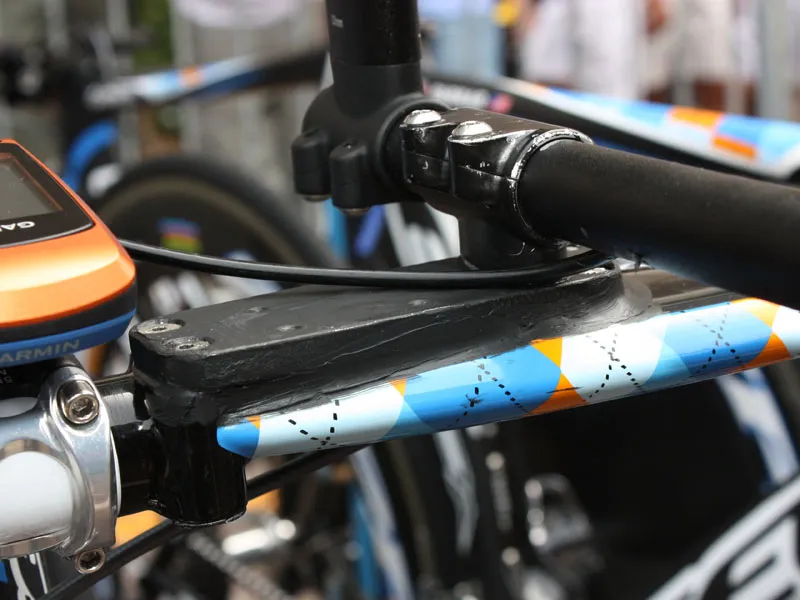
Garmin-Slipstream team mechanics had to craft additional support plates to accommodate some riders' aero positions.
Garmin-Slipstream's riders had among the most diverse array of aero bar setups in the field and the team mechanics and sponsors had to employ some out-of-the-box thinking to get everything to work, especially given the relatively last-minute swaps to 3T's Mistral bar in order to satisfy the recently 'clarified' UCI technical guidelines. Most of the riders preferred to run their base bars low and their extensions high - plus elbow pads mounted further back under their arms - and though the Mistral offers a reasonable variety of armrest width options, custom clamps and fittings were still the norm rather than the exception.
The narrow positions of time trial specialists such as David Zabriskie, David Millar and Bradley Wiggins seemed fairly easy to accommodate but setting up others such as Julian Dean and Ryder Hesjedal wasn't nearly as straightforward. Their extra-wide arm spacing and rearward elbow pads required additional plates mounted atop the base bar for more mounting stability plus custom clamps all around for the extensions and elbow rests.
Unfortunately, those low base bar positions also forced the mechanics to get creative with the brakes, too, given the tight constraints for cable housing. Team mechanics hacked off the upper arm ends - including the barrel adjusters - and drilled new housing stops in the newly truncated stubs. The altered brake geometry surely affected the stopping performance, but it all seemed to work well enough to get the job done.
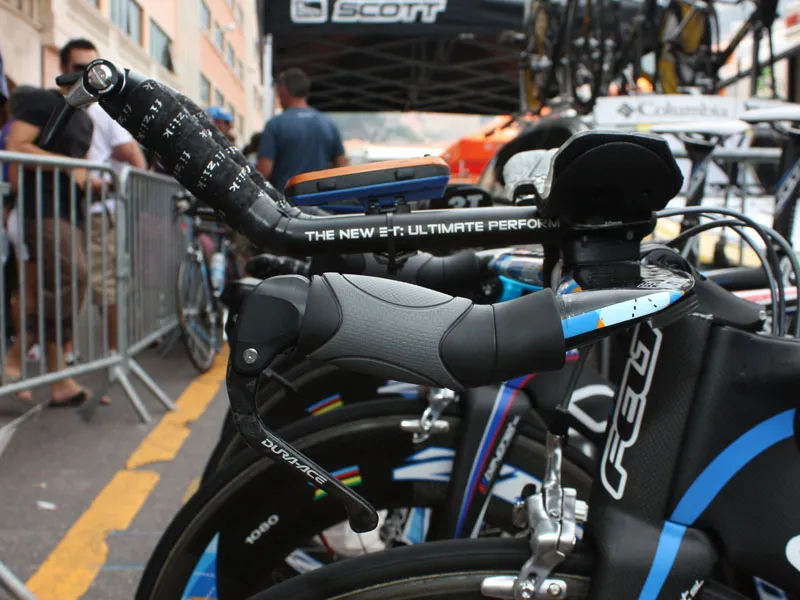
David Millar (Garmin-Slipstream) apparently likes a little extra grip on his base bars, too.
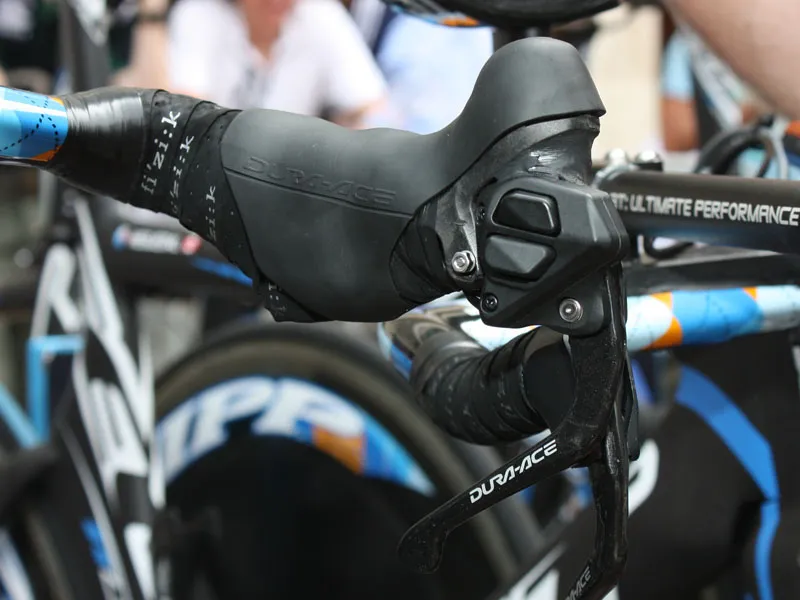
Bradley Wiggins had perhaps the most unique base bar grip setup in the peloton with this custom-made hybrid of Shimano Dura-Ace 7900 STI and Di2.
Even grips weren't ignored. Millar's base bars had rubber mountain bike grips slide over the ends for a surer purchase while Wiggins' setup was a custom hybrid of Dura-Ace 7900 Dual Control levers and Di2 integrated units. Mechanics gutted each 7900 lever - leaving just the body and hood - then slid the whole thing around the base bar and filled in the gaps with some silicone. Though the end product wasn't particularly pretty (or light) it was definitely one of the grippiest base bar setups we've come across.
In contrast, the team's Felt Bayonet fork assemblies have gotten decidedly cleaner and more elegant. Felt supplied custom forks with shorter external steerers plus more aggressively proportioned upper caps to match, thus doing away with the doubled-hinged stems of earlier setups needed to accommodate the ultra-low base bar positions. Most of the caps on the team bikes clearly came off of the CNC machine so it's unclear at the moment whether or not the revised front ends will be offered for consumer sale.
Shimano Dura-Ace Di2 popular choice for Stage 1
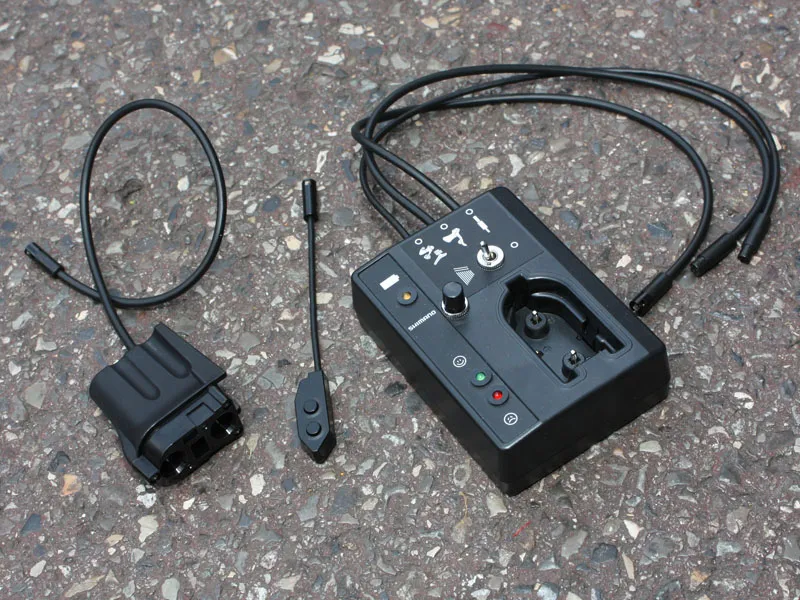
The diagnostic tool is designed as an electronic 'go-no go' gage, helping mechanics isolate which Di2 component might have an issue.
Stage 1's highly technical course demanded keen handling skills with its varying grade and dizzying array of tight hairpin turns through the streets of Monaco. Riders were constantly swapping from the outer grips to the aero extensions but many Shimano-sponsored riders may have actually been able to save a smidgeon of time as a result.
Though Shimano's new Dura-Ace Di2 system still isn't ubiquitous in the peloton on the road stages, nearly the entirety of the Rabobank, Garmin-Slipstream and Columbia-High Road TT fleets were so equipped. Speedy shifting, ultra-short button throws and fancy auto-trimming front derailleur aside, Di2's biggest draw here was perhaps the multiple sets of shift buttons - one pair out on the aero extensions as usual but another neatly integrated into the brake levers mounts on the base bar.
As such, riders could easily upshift as they accelerated out of the start house or shot out of corners, or downshift in the midst of tight turns. While other riders could be seen getting in an out of the saddle just to reach their standard extension-mounted shifters, Di2-equipped riders could more easily keep their rhythm and maintain their preferred position. Even so, it still wasn't enough to keep Swiss beast Fabian Cancellara (Saxo Bank) from pummelling the field to take the first yellow jersey of this year's Tour.
The SRAM-sponsored Agritubel riders were apparently also concerned about the ability to shift while on more technical situations but they took a decidedly different tack. Instead of using proper time trial shifters, about half the team opted for standard Red DoubleTap levers mounted to the base bar, leaving the extensions oddly bare.
Prologo's new Nago Evo TTR saddle
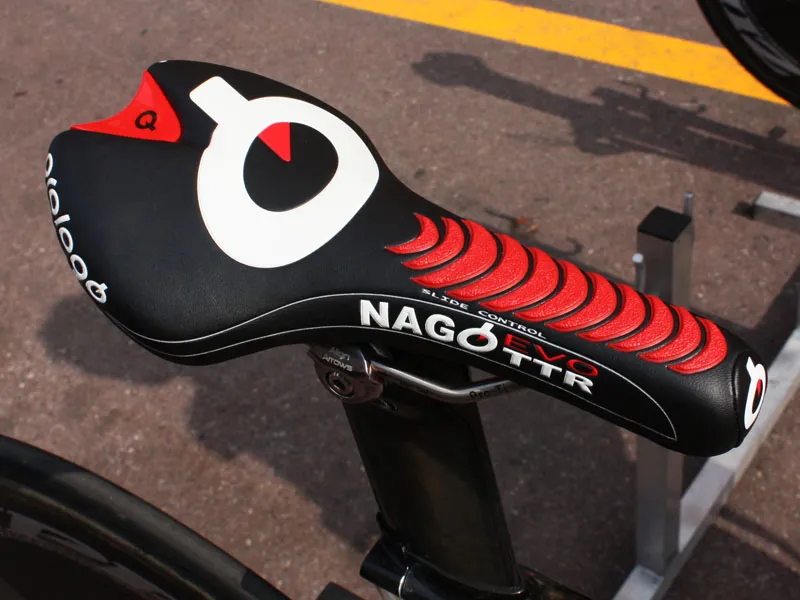
Prologo says its new Nago Evo TTR was specifically designed for time trials at the request of Saxo Bank team director Bjarne Riis.
Those watching video during Stage 1 of Alberto Contador (Astana) and Denis Menchov (Rabobank) may have noticed the two riders repeatedly sliding forward on their saddles and then pushing themselves back into position. One rider that had no such issues however was winner Fabian Cancellara (Saxo Bank) who appeared firmly planted as he powered through to victory.
Cancellara can perhaps credit his new time trial-specific Prologo Nago Evo TTR saddle, whose development was specifically requested by team director Bjarne Riis. Prologo says the Nago Evo TTR has two distinct seating positions: a specially shaped nose to better accommodate a full aero tuck plus a Scratch-like rear for use when on the base bar and slightly more upright.
For the former, Prologo uses a set of uniquely raised and textured grip strips called 'Slide Control' to securely plant the rider in place, thus eliminating the need for add-ons commonly used by much of the peloton (Menchov's saddle had some additional stick-on foam strips when didn't seem to work very well). In addition, the forward section is especially wide and well padded to provide enough comfort to stay in that position without grimacing plus the nose is also shortened in order to more easily satisfy UCI guidelines for saddle setback.
Prologo will offer the Nago Evo TTR to the public in two versions: the 176g Nack 10 with carbon rails for €189 and the 226g Ti Solid with titanium rails (used by Cancellara) for €139.
